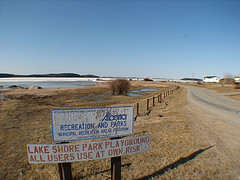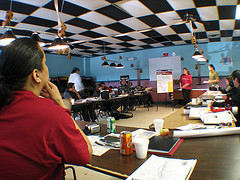Update: Pictures from the trip are here.
I’m in a pool hall in Fort Chipewyan, Alberta, about 1,800 miles north of my home in San Francisco. The only road that extends this far north is made of ice that’s passable just three months a year. Any other time, you have to fly in. That’s how I arrived yesterday, on the invitation of community leaders, to learn about one of the most destructive and least known industrial projects on the planet, the Canadian tar sands.
The geographic isolation of Ft. Chip has helped to preserve a relatively traditional way of life for its 1,200 residents—mostly Cree and Dene native peoples—for generations. Hunting, trapping and fishing remain a central part of the culture, providing most folks here with dietary staples.
 I’m listening to stories from those in the pool hall about how the tar sands is changing all that. Ariel, a young woman who grew up here, explains that “I drank from the lake when I was a kid but today we’re not even supposed to swim in it because it’s too toxic.” Another new father is more blunt. “All my relations are dying,” he says “If we don’t do something soon, just living in Ft. Chip will be a death sentence.”
I’m listening to stories from those in the pool hall about how the tar sands is changing all that. Ariel, a young woman who grew up here, explains that “I drank from the lake when I was a kid but today we’re not even supposed to swim in it because it’s too toxic.” Another new father is more blunt. “All my relations are dying,” he says “If we don’t do something soon, just living in Ft. Chip will be a death sentence.”
Aside from health, people are also concerned about their culture. Fishing, hunting and trapping have been at the center of seasonal community celebrations here for as long as anyone can remember. With the decline in water quality, however, populations of fish and muskrat have become too toxic to eat. “I don’t know what we’re going to leave our children or our grandchildren” says mother and traditional chef in the community, “It’s scary, really scary… I hope we can find some solutions. It just looks so bleak.”
 This afternoon we’re gathered at the pool hall to begin laying the groundwork for solutions. Tom Goldtooth of Indigenous Environmental Network starts with a presentation on environmental justice and the power of spiritual practice. George Poitras follows with legal strategies being deployed by Mikisew Cree First Nation. Macdonald Stainsby and Dustin Johnson paint a picture of the developing continental grassroots resistance among indigenous and other historically marginalized communities from the perspective of TarsandsTruth.org and North Coast Envirowatch.
This afternoon we’re gathered at the pool hall to begin laying the groundwork for solutions. Tom Goldtooth of Indigenous Environmental Network starts with a presentation on environmental justice and the power of spiritual practice. George Poitras follows with legal strategies being deployed by Mikisew Cree First Nation. Macdonald Stainsby and Dustin Johnson paint a picture of the developing continental grassroots resistance among indigenous and other historically marginalized communities from the perspective of TarsandsTruth.org and North Coast Envirowatch.
Tonight we feast with community Elders. Tomorrow it’s back to the pool hall to begin building an organizing framework and developing strategy for the coming months. “This is the start of unification in the community” says a new father and community leader “this is going to be the start of a big thing.”